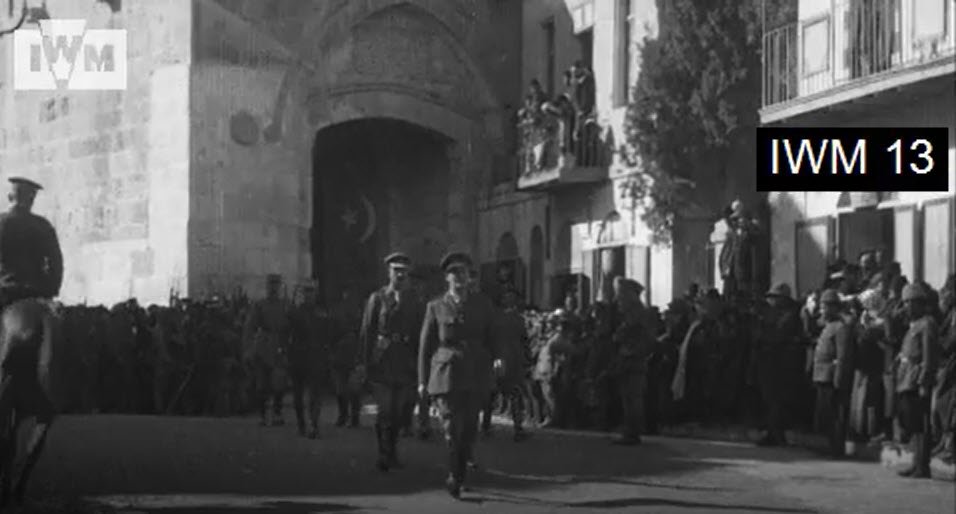General Edmund Allenby’s entry into Jerusalem through the Jaffa Gate on December 11, 1917, is captured here in rare video footage from the British Imperial War Museum. The footage, while silent, is unusual in that it includes and depicts the populace, insofar as they were out on the streets to witness the moment. This, too, makes it historically significant.
In World War I, Allenby led the British Empire’s Egyptian Expeditionary Force (EEF) during the Sinai and Palestine campaign against the Ottoman Empire in the conquest of Palestine. Jerusalem was the third city conquered, preceded by Beersheba (on October 31) and Gaza (on November 7).1 But the December conquest of Jerusalem, although not the end of the campaign, was nonetheless pivotal.
Allenby was the first Christian to control Jerusalem in centuries, a fact that was reflected in Allenby’s reportedly saying at the time, “the wars of the crusades are now complete,” phrasing that was subsequently parroted by the British press and Information Department.2 The British conquest of Jerusalem, marking the beginning of an occupation, would prove to be a fateful turning point in the trajectory of the city.
As one historian’s recounting of this event described it:
“The British government was, of course, concerned about its reputation, and planned a propaganda coup which would help to establish the British ‘right’ to rule in the city. There is nothing quite so suggestive of sheer power as the conspicuous refraining from exercising and displaying it . . .
“In their preparations for the conquest of the city, the British also wanted to present themselves as contrasting with the behaviour of their enemies. What was particularly in mind in the case of Jerusalem was the behaviour of the [German] Kaiser twenty years earlier. On a state visit, he had ridden into the city on a white horse through a section of the city wall which had been demolished especially for him. So both these actions – the horse and the demolition – had to be avoided, as had any hint of violence in the city – for these were the behaviour traits the Allies had particularly affixed to Turkish and German reputations . . .
“General Allenby came to Jerusalem on December 11, a fortnight before Christmas, two days after the Jewish feast of Hanukah – which was the day of the city’s surrender – to make his ceremonial entry.
“Allenby’s entry had been carefully prepared according to instructions from Britain received well in advance. The studied lack of ceremony was itself ceremonious, but replete with all the necessary symbols. He was welcomed by the city’s military governor, Brigadier-General M. W. Borton, providing a strong hint of the iron fist: Borton had already established a clear military control over the city. The velvet glove was Allenby’s act of walking into the Holy City, conspicuously avoiding the hole in the wall broken for the Kaiser nearly twenty years before. But the Jaffa gate was no more than 20 yards from the Kaiser’s gap, and it was opened especially for the new conqueror; the first time for decades it had been so used. Was it more arrogant to have a gate specially opened, or to have a hole made in the wall? And, of course, being a general and a conqueror, Allenby had a guard of honour.
“In fact there were four of them. As he approached the gate – having climbed down from his Rolls-Royce (he didn’t have very far to walk) – there were fifty British soldiers, carefully including English, Welsh, Scots, and Irish, to the right, and to the left fifty Australians and New Zealanders, also carefully representative of all their homelands; these men had been selected, and then trained, polished, and primped up for the past three weeks in preparation for this occasion. Inside the gate there were twenty French soldiers to the right and twenty Italians to the left, representatives of the Allies involved in the war against Turkey alongside the British Empire.
“Allenby was also accompanied by a flock of officers. His own aides included Lord Dalmeny, the son of the Earl of Rosebery, the former Prime Minister, whose younger brother had died at Abu Shushe. Colonel Wavell represented the War Office. The French and Italian contingent commanders were there, as were their and Allenby’s senior staff officers. Also attending was Georges Picot, the French High Commissioner for Syria (still to be conquered), and one of the negotiators of the pact which had laid down the lines on which the lands of the Levant were to be divided between Britain and France. Major T. E. Lawrence was present by special permission of General Allenby, perhaps the nearest to a representative of the Arab Revolt who was available.
“All in all, it was a very military occasion . . .
“The city notables at last met the man to whom they had surrendered, and heard a conciliatory proclamation promising continuity and protection, even though the city was now under martial law. Already a guard of Indian Muslim soldiers from the 58th Vaughan’s Rifles had been placed on the Haram esh-Sharif, the Muslim Mosque of Omar, and the traditional Muslim guardians of the Temple site were assured that their office would continue. This last was a suggestion from Lloyd George, prompted by Sir Mark Sykes, both of whom had taken a minute interest in all these details. It was, after all, an overwhelmingly Muslim and Arab city which had been conquered, and the majority population had to be conciliated. The proclamation was in six languages, the English, French, and Russian of the Allies, plus Hebrew, Arabic, and Greek, local languages.
“As a propaganda gesture all this was very satisfactory and most successful. The practical reassurances might be directed at the local population, but the propaganda was aimed squarely at Christian Europe and America . . .
“Yet in political terms it was military power on the ground which counted.”3

